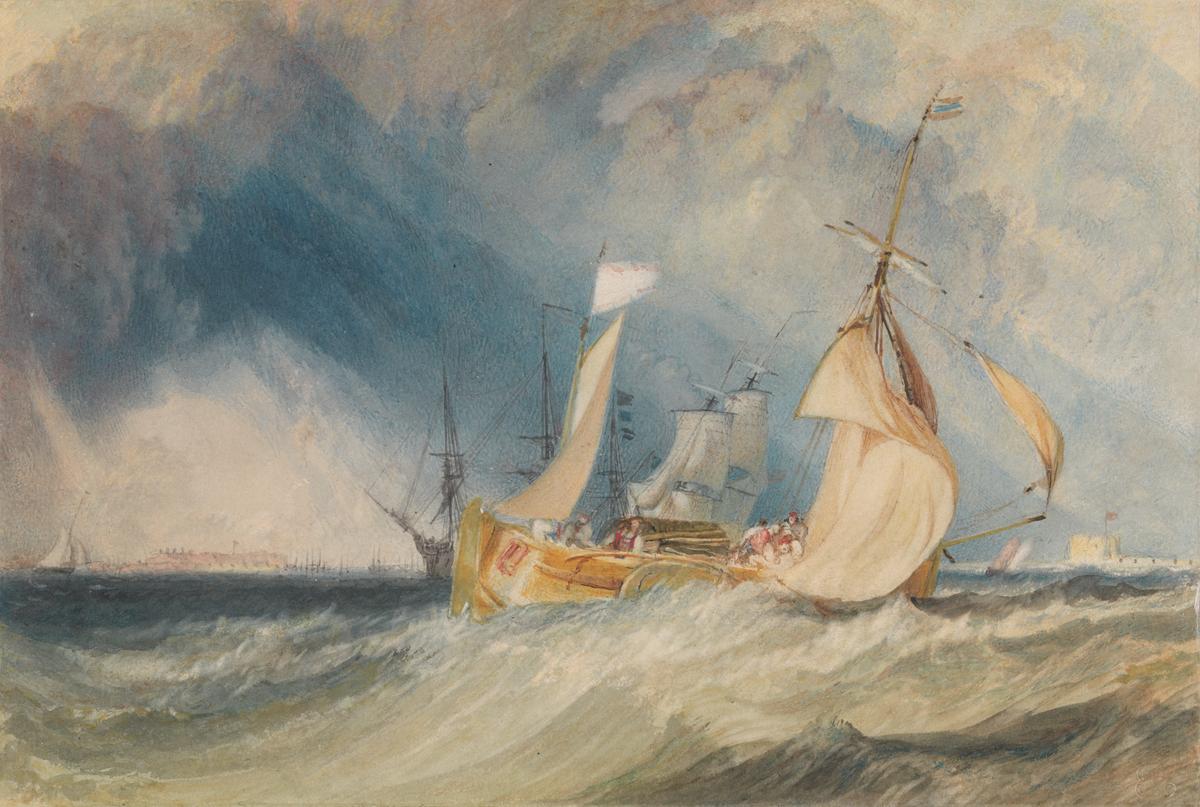Joseph Mallord William Turner The Mouth of the River Humber c.1824-5
Joseph Mallord William Turner,
The Mouth of the River Humber
c.1824-5
Joseph Mallord William Turner 1775–1851
The Mouth of the River Humber c.1824–5
D18151
Turner Bequest CCVIII R
Turner Bequest CCVIII R
Gouache and watercolour on white wove watercolour paper, 162 x 242 mm
Blind-stamped with Turner Bequest monogram, bottom right
Blind-stamped with Turner Bequest monogram, bottom right
Accepted by the nation as part of the Turner Bequest 1856
Exhibition history
1904
National Gallery, London, various dates to at least 1904 (378).
1936
[Display of Watercolours], National Gallery, London, November 1936–September 1939 (no catalogue).
1951
An Exhibition of Paintings by J.M.W. Turner (1775–1851) to Commemorate the Centennial of his Death, Art Gallery of Toronto and National Gallery of Canada, Ottawa, October–December 1951 (49).
1980
Turner at the Bankside Gallery: Drawings & Water-colours of British River Scenes from the British Museum, Bankside Gallery, London, November–December 1980 (60).
1983
J.M.W. Turner, à l’occasion du cinquantième anniversaire du British Council, Galeries nationales du Grand Palais, Paris, October 1983–January 1984 (153 reproduced).
1987
Watercolours from the Turner Bequest, Tate Gallery, London, April–October 1987 (no catalogue).
1997
J.M.W. Turner 1775–1851: A Tate Gallery Collection Exhibition, Yokohama Museum of Art, June–August 1997, Fukuoka Art Museum, September–October 1997, Nagoya City Art Museum, October–December 1997 (44, reproduced in colour).
1997
Joseph Mallord William Turner, Bank Austria Kunstforum, Vienna, March–June 1997 (52, reproduced in colour).
2003
Turner’s Britain, Gas Hall, Birmingham Museums & Art Gallery, November 2003–February 2004 (85, reproduced in colour; pl.9).
References
1904
E.T. Cook and Alexander Wedderburn (eds.), Library Edition: The Works of John Ruskin: Volume XIII: Turner: The Harbours of England; Catalogues and Notes, London 1904, p.626, no.378, as ‘The Mouth of the River Humber’.
1909
A.J. Finberg, A Complete Inventory of the Drawings of the Turner Bequest, London 1909, vol.II, p.630, CCVIII R, as ‘Mouth of the River Humber’.
1990
Eric Shanes, Turner’s England 1810–38, London 1990, p.112, no.87 (colour).
This view encompasses Spurn Head at the right and Grimsby in the distance on the left where a parade of vessels can be seen anchored in the river. Grimsby is framed compositionally by a vortical shape formed by the space created between the arc of storm clouds above and the curving swell of the waves below. Turner has applied swift strokes of gouache to accentuate the turbulent swell of the Humber.
Eric Shanes writes that ‘As was common in most of his marine vistas, Turner eschewed the even distribution of his shipping across a wide arena and instead jumbled it all up together, reveling in the variety of abstract forms that such a juxtaposition creates’.1 The same effect is found in the shipping in The Medway watercolour for the Rivers series (Tate D18149; Turner Bequest CCVIII P). In the foreground sailors in a Billy-boy (a form of river barge and coasting vessel) battle against a squall, orientating the rigging to control the force and velocity of the wind through the sails. Behind it is a brig tacking in the opposite direction, and last, in the middle distance, a man-of-war at anchor. Shanes notes that ‘the design in unified by a subtle arabesque line which runs around and down the emerging line of light in the distance on the left, along the Billy-boy’s gunwale, and up the edge of its mainsail back into the sky and beyond’.2 The tempestuous and dynamic view is aptly described by Barbara Hofland, who writes that the Humber here ‘partakes the character which generally belongs to that mighty congregation of water when pent between banks and fretted by obstacles’.3
Finberg suggests that a colour study for this drawing may be found in Turner’s Ports of England sketchbook of about 1822–3 (Tate D17739; Turner Bequest CCII 20).4 He also lists four pencil sketches on loose sheets as being possible studies for the shipping in this watercolour (Tate D17762–D17765; Turner Bequest CCIII E–F).5
Verso:
Stamped in black with Turner Bequest monogram and ‘CCVIII R’ at centre; inscribed in pencil ‘CCVIII R’ and ‘39’ at centre towards left.
Alice Rylance-Watson
March 2013
How to cite
Alice Rylance-Watson, ‘The Mouth of the River Humber c.1824–5 by Joseph Mallord William Turner’, catalogue entry, March 2013, in David Blayney Brown (ed.), J.M.W. Turner: Sketchbooks, Drawings and Watercolours, Tate Research Publication, August 2014, https://www

